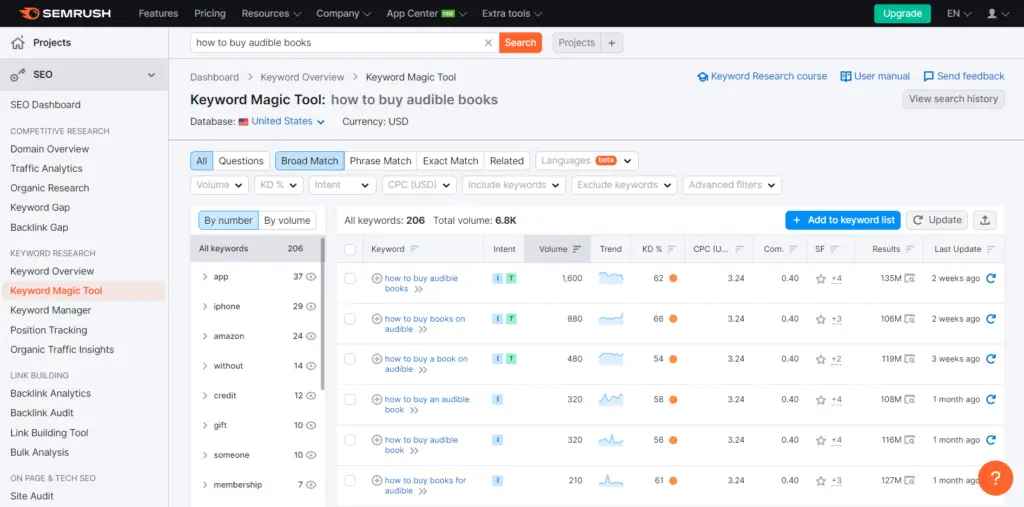Disclosure: Sportshubnet is supported by its audience. When you purchase through links on our site, we may earn an affiliate commission. Learn More.
In this post, we will check out the top 10 ways to optimize your blog posts for SEO in 2023.
Blogging is a great way to build your brand and drive inbound traffic, but if you want your blog posts to do well in the search results, you need to optimize them for SEO.
Optimizing your blog posts for SEO can be a daunting task. There are many elements to consider when writing a blog post in order to optimize it correctly.
The purpose of this article is to cover some of the most important items that you should be taking into consideration before you publish your next blog post.
The good news is that optimizing your blog posts for SEO doesn’t have to be difficult—there are lots of simple steps you can take to make sure your content ranks higher than similar pieces written by other bloggers.
There are a lot of different things to consider when creating an individual page of content. What are the most important factors in Google’s ranking algorithm? How do I optimize my blog posts for the search engine spiders?
How many of you have written a blog post, published it to your blog, and then moved on… Just checked out? Well if you have then you’re going to want to read this article. Phew! Hang in there with me when I say that blogging is like an iceberg.
When your blog posts are complete, it’s time to optimize them for search engines. Before we go further into the ways to optimize your blog posts for search engines, we need to decide why you are optimizing your blog posts for search engines.
Why Optimize Your WordPress Blog Posts for SEO?
The short answer is that SEO helps drive traffic to your blog.
The longer answer is that SEO is the practice of optimizing your content so that search engines can find it, index it, and rank it based on the words used in the content.
There are two main benefits to optimizing your blog posts for SEO:
- More Traffic: Search engines send traffic to sites when they rank those sites higher in their search results. By optimizing your content with keywords, you increase your chances of ranking high enough in search results to get more visitors from Google and other search engines.
- Better Conversion Rates: Optimizing for SEO also improves conversion rates because people are more likely to click on links that come up higher in search results. If someone searches for a specific keyword or phrase, there’s a good chance they’re interested in reading about it and buying something related, so if you optimize your content with that keyword or phrase, you’ll likely get more clicks from readers who are ready to buy something related to what you wrote about.
10 Ways To Optimize Blog Posts For SEO 2023
1 Plot Your Content with Proper Keyword Research
You can’t just write content and expect it to go viral. You need to plan your content and use proper keyword research.
Keyword research is a process that helps you find out what people are searching for, so you can make sure your content is relevant.
You can start by doing some basic keyword research on Semrush. It’s quick and easy to use.

Simply enter in a phrase or word related to your topic, such as “keyword research tool” or “best SEO tool”, and then select the location where you’d like to target potential readers.
The tool will give you suggestions for other keywords based on how many searches they receive each month, how much competition there is for those terms, and more.
You might find that some of these results are similar or even identical — this is because they’re actually synonyms that people use interchangeably when searching online. For example, if someone searches “how do I make money online”, they could also be searching “make money online” or “earn money online”.
When choosing keywords for your content, try to choose long-tail keywords as they are broad in nature and keyword difficulty is low.
2 Make the Most of Your Title Tag
The title tag is the most important on-page SEO element. It’s the first thing people see when they search for your site and it needs to be optimized to attract as much traffic as possible.
The best way to optimize your title tags is by making them descriptive and including your keyword at least once in each one. The keyword should be included at the beginning of the sentence with no more than two synonyms (e.g., apple juice instead of apple cider).
The following example uses several components that make up a high-quality SEO title tag:
- Descriptive text that includes a keyword phrase
- Keyword first in a sentence
3 Find Semantic Keywords For your Focus Keyword
When you’re creating a content marketing strategy, it’s important to understand which keywords you want to target. These are the words that describe the topics and ideas in your content. They are also known as “focus keywords.”
For example, if your company sells high-quality dog food, your focus keyword might be “dog food.” This would be the main theme of all of your content, and any other keywords would be used to describe specific aspects of this topic. For example, you might also include keywords like “organic dog food,” “cheap dog food” or “canned dog food” in some of these articles.
Focus keywords should be easy for people to understand and use when searching online. That way, anyone who is interested in learning more about a particular topic can find useful information quickly using search engines like Google and Bing.
4 Include a Meta Description
Meta descriptions are a short summary of the article, and they are used in search engines to describe the article.
This is typically what people will see when they do a search for keywords related to your post. You want this description to be compelling enough that it persuades them to click through and read your content.
You can also use meta descriptions as an opportunity to rank for keywords (for example, if you publish an article about how to use social media marketing on Twitter, then you could include “Twitter” in the meta description).
5 Do Internal Linking In Blog Posts
Internal linking is a good way for search engines to crawl through your website. It also helps visitors understand the structure of your site.
Internal links are the links that you use within your own blog post, or between different pages on your blog. Internal links can be used to link to previous posts, other posts on your site, or external sites.
The best way to create internal links is to use keywords in the text of your post. For example, if you are writing a post about skiing and snowboarding, you might include a sentence like “Here’s my favorite ski resort in Colorado: Winter Park Resort.”
This would link back to an older post that had the keyword “ski resort” in it. This will help search engines find relevant information about ski resorts and could improve their rankings in those searches.
You can also use internal linking as part of a content strategy for improving search engine rankings and increasing traffic.
6 Use keywords in your URL
A good URL is a good URL. The goal of your URL should be to make sure that the reader can easily find the content they are looking for and not get confused by any additional information.
If you are using keywords in your URLs, make sure that they still read as a URL and not something like [keyword].com/blog/SEO-tips/. The entire point of using keywords in your URL is so people will be able to find it when searching Google and other search engines, so if you start adding extra characters or words like “related article” or “read this”, it defeats the purpose.
A good rule of thumb is no more than 4 words total in order to keep things simple for users who may not know what all those numbers mean.
7 Add Images and Videos to Your Blog Posts
Images and videos help you get your point across and make it easy for people to understand what you’re talking about.
They also help you stand out in the crowd because most other blogs don’t use them as often as they should. Here are some tips for adding images and videos to your blog posts:
Use images that support your points. If you talk about a product or service, include an image of it. If you write about a location, include an image of that place.
It doesn’t have to be a professional-looking photo, but it should show what you’re talking about clearly enough that it doesn’t require reading your words to understand what the image is showing.
There are plenty of places to find royalty-free images to use in your blog posts.
You can also use your original photographs or use top web design software like Adobe Photoshop and Canva to create your own.
Use photos when possible — even if they aren’t professionally taken — because they add interest and color to your content without requiring much effort on the part of the reader or writer.
Include videos if they’re relevant to your post, but keep in mind that don’t host your video files in your WordPress rather than upload your videos to a video hosting site like YouTube or Vimeo. These sites are built to host your videos and can even be an additional traffic source.
8 Use Header Tags to Structure Your Content

Header tags are a way to structure your content, and they’re particularly useful for SEO. By using header tags like H1, H2, and H3, you can organize the information in your blog post around different topics.
Use an H1 tag to mark up the most important topic in a sentence or paragraph (the title of the blog post itself is often marked up as an H1). An H2 tag should be used for any subheadings within these main topics, while an H3 tag can be used for even smaller points of information that support those main points (and so on).
This helps search engines understand what each section of your article is about—which is especially important if it’s long! By helping them understand how everything fits together, it makes it easier for them to crawl through all this great content you’re providing them with so they can show others how amazing your site is.
9 Make Your Articles Easier to Read
A reader who can’t read your article is a lost reader.
When you write an article, it’s easy to get caught up in the excitement of the topic and forget that your readers might not understand what you’re talking about.
Here are some tips to make your articles easier to read:
Use short paragraphs. It makes it easier for your readers’ eyes to scan for information and makes the text easier to digest. Long paragraphs can be intimidating and difficult to comprehend.
Use lists and bullet points when possible. Lists are great for listing items but don’t always work well as paragraphs of text. Use them sparingly (no more than three items) and only when they make sense within the context of the article.
Write with correct grammar and spelling. This one may seem obvious but it needs to be said – use proper grammar and spelling when writing your article so that it doesn’t become confusing or difficult for people to understand what you mean when they read it!
You can also use online grammar checker tools like Grammarly to check for grammar, punctuation, and spelling mistakes on your post.
10 Optimize Your Images With alt Tags and Title Tags
Image optimization is another area where you can make your images more search engine friendly. The alt tag is the text that appears when someone looks at your image, either on desktop or mobile.
It’s also used by screen readers and people with slow internet connections. Alt tags should be relevant to the image, concise, and descriptive of what it is related to.
You can use the same keywords as you would include in a meta description for this particular page of content, but don’t forget that alt tags are also picked up by search engines—so an alt tag like “dog” will give the search engine no information while one like “my medium-sized fluffy dog who loves playing fetch with me in my backyard” will provide much more value.
11 Use Categories and Tags to Organize Content

Categories and tags are two ways to organize content on your site. Both can be used for the same purpose, but they’re different.
Categories are a way to group similar posts together. For example, if you have a blog about cooking, you might have categories like cake recipes and vegetarian recipes.
Categories help readers who are looking for specific types of content find it more easily. They also help you keep track of how many posts you’ve written about each topic so that you can plan future posts.
Tags are keywords or phrases that describe what each post is about. They show up as clickable links in the body of a post and in the “tags” section at the bottom of each post’s page.
You can add multiple tags per post if there are several relevant ones. Like categories, tags can help readers find your content more easily — but unlike categories, they don’t tell readers what kind of content they’ll find inside each tag link; they just give them another way to search within your site’s archives.
12 Make Your Blog Posts Extensive
These are what make a blog post comprehensive and ensure that your readers are satisfied with the experience they have while reading it.
The Importance of Completeness in Your Blog Posts
While there are many things you can do to make your blog posts more comprehensive, there are three main elements that can help you achieve this:
Informative content — You want your readers to know everything they need to know about your topic.
Understandable language — You want your readers to be able to understand what you’re saying so there’s no confusion or misinterpretation of any kind.
Relevant information — You want the information you provide on your blog post to be relevant to the topic at hand so that it provides value for the reader.
13 Optimize Older Blog Posts
Your blog posts are your most important content, but they can also be the most difficult to optimize.
Publishing a new blog post is like planting a seed in the ground: You don’t know if it will grow and flourish or die out.
The only way to find out if your content is effective is by tracking engagement metrics over time. If you want to see results from your efforts, you’ll need to optimize older blog posts as well as publish new ones.
Why Optimize Older Blog Posts?
Optimizing old blog posts can help boost traffic and lead generation for your business. Here are three reasons why it’s important:
1) Search engine indexes recent content more frequently than older content, so search engines are more likely to rank your site if you have more recent content on it.
2) Many people find older content through search engines, not just from links within social media or other websites — so optimizing older posts can help increase their visibility in organic search results and drive more traffic back to your site.
Always remember you need to do the following things after publishing your blog posts:-
The hardest part about publishing a blog post is over. Congratulations! You’ve taken the time to create a great piece of content, and now it’s available for the world to see. But before you can pat yourself on the back, there are some things you should do after publishing your blog post.
- Track Keyword rankings
You have optimized a post for SEO, now it’s time to track your progress, It’s difficult to improve without knowing where you stand. Check out our post for the best SEO rank tracker tools for keyword tracking.
Google Alerts is a free tool that lets you monitor certain keywords in Google News. It’s a great way to learn what people are saying about your business or product, as well as any trends in specific industries. You can also set up alerts for topics related to your content so you’ll know when someone else publishes something similar.
- Share Your Post on Social Media and Other Sites
Once you have published your post, share it with everyone who might be interested in reading it: followers on social media sites like Facebook and Twitter; friends and family; other bloggers who may be interested in covering it; etc. You can also submit your content to article directories like EzineArticles, which will help drive traffic back to your site.
- Link Back To Other Writers’ Work
Be sure to add links throughout your article to other articles that support your claims or provide more information about a topic
Conclusion
By following these tips and using the right tools, you can make your content stand out in search results. You’ll be able to reach more people who are looking for exactly what you offer, which means more traffic and leads for your business!
Inbox looking a bit bland?
Better sign up to our blog to cram it full of trending Sports, Gaming & Tech updates.




